A religious tour of Britain
 Brewster Scholarship Travel Report – Alan Yang
Brewster Scholarship Travel Report – Alan Yang
With the help of the Brewster Scholarship and University College, Oxford, I was able to travel to a number of different churches and associated towns in Britain. These included Westminster Abbey, Worcester Cathedral, Salisbury Cathedral, Canterbury Cathedral, York Minster, Durham Cathedral, Hexham Abbey, and St. Giles Cathedral. The last four sites were visited in one long weekend trip up North, which was delightful. During my two years here in England, it felt necessary to visit the northern bits of the country at least once, and I am very grateful to have had the opportunity to get my first glance through the support of the Brewster Scholarship.
Westminster Abbey
Westminster Abbey is probably the most famous of England’s churches amongst Americans, primarily due to the televised royal weddings. I was therefore very excited to step foot in this abbey before I even made it inside.
The Abbey was gorgeous. The marble statues, the Latin and English inscriptions, the magnificent building itself—it was a feast for the eyes. But what I enjoyed most was engaging with early British heritage, and feeling awed by it. The likes of Spenser, Handel, Newton, Chaucer, Shakespeare, and of course many of the monarchs were all memorialised or buried at the Abbey. While walking around and looking at the different tombs and memorials, I gained a deeper understanding of Britain’s contributions to humanity. A museum could not have done it better.
Worcester Cathedral
Worcester Cathedral was very nice, though sadly I did not get a chance to attend a service. To an American like me, it is amazing that even a run-of-the-mill town like Worcester boasts these grand cathedrals. You never see that in America—even major cities don’t necessarily have imposing church buildings. I tried to imagine what it must be like to grow up in a town like Worcester. To have all the comforts and technologies of modern life—iPhones, cars, and laundry machines—but still feel tied to a much deeper and older history and be reminded of that link every day by the sight of the ancient cathedral. I do think there’s a greater sense of history and heritage in Britain—a feeling that you are the modern reincarnation of a long line of people who used to stand on this same patch of earth. The cathedral is evidence of this.
Salisbury Cathedral
It was the day before the winter solstice. I arrived in Salisbury by rail in the afternoon and made a beeline for the cathedral. Salisbury Cathedral was gorgeous, and again, an instance of how the long history of a seemingly little town actual is made evident by the existence of a grand cathedral. Seeing the Magna Carta inside the Cathedral was very cool.
The following day, we (I and three other friends) set out very early in the morning by bus and foot to reach Stonehenge so that we could witness the sun rise there on the the solstice day. The rocks of Stonehenge are usually cordoned off and unreachable by the public, but on the two solstices, people can go up and touch the rocks. I did this, and I couldn’t believe my own fingers—my skin—were touching these primordial rocks which had been miraculously moved here by people so long ago. We also got to witness various modern pagan groups perform their rituals to celebrate the shortest day of the year and to welcome the increasing light to come.
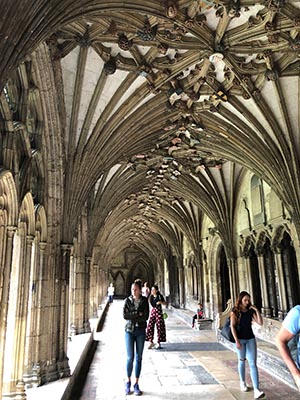 Canterbury Cathedral
Canterbury Cathedral
Despite almost missing my train, I managed to make my way to Canterbury with my friend Sam from London. Canterbury Cathedral was very beautiful, especially its cloisters. We attended an evensong in the afternoon. I was glad I got to visit the seat of the Anglican church.
Later that day, we journeyed onwards toward to Dover, the gate to the Realm, where we hiked along the White Cliffs of Dover, a marvelous sight to behold. We also could see the edge of France off in the distance, and I was shocked by how close the two countries are! No wonder so many folks throughout history—the Romans, the Danes, the Normans—came to conquer the Isle. It was right there in perfect view tempting them every day!
York, Durham, Hexham and Edinburgh Trip
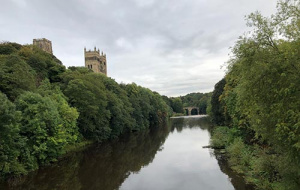 York
York
Friday morning I caught an early train to York via King’s Cross London. When I got there the first thing I saw was the old city wall with its ramparts, snaking along to my left and to my right. I walked towards Bootham Bar where my friend John already was on a free walking tour. On my way there I walked across a bridge over the river and saw two old towers that used to be connected by a giant iron chain during medieval times, according to a sign. In the distance York Minster rose above the other roofs like a god amongst men.
As I walked on top of the walls of York, I couldn’t help but think how incredible it was that the Romans had made it all the way up here, and indeed the same state that governed this island also ruled the deserts of Morocco at the same time. Even today, with modern transportation, it’s quite the journey from Britain to Morocco, not to say Israel or Turkey. How the Romans managed to govern such a vast territory is unimaginable. But somehow they did, uniting it under one emperor, one military, and one official language. The Roman inscriptions excavated at York are of the same style and in the same language as those found in Jordan.
John and I walked around and had a delicious Yorkshire pudding for lunch before setting off for Holy Communion at York Minster. By now it had started raining, so we quickened our pace. The cathedral was beautiful, as expected, especially its magnificent east window, whose stained glass panels were organized into groups of three to symbolise the Holy Trinity. The service itself was very calming and reflective.
As we headed out of the cathedral, we ran into a Roman column from the first century AD that was only unearthed in 1969. We visited the York Shambles afterwards, which was cute, then headed back to the station to go to Durham.
There’s a special charm of small towns like York. While walking around town, I often found myself thinking I was in a storybook, like I had gone to sleep and awoken inside a Grimm’s fairytale. In America, we only see images of old European town buildings—by which I mean the smaller, quainter, more colourful, and slightly asymmetrical buildings—in illustrated children’s tales or Disney movies. The imagery from Beauty and the Beast would be a good example. So when I’m in England and elsewhere in Europe, walking down roads with these kinds of old town buildings is a magical experience. I don’t know how Europeans themselves feel—maybe they’re used to it—but for me it’s like magic.
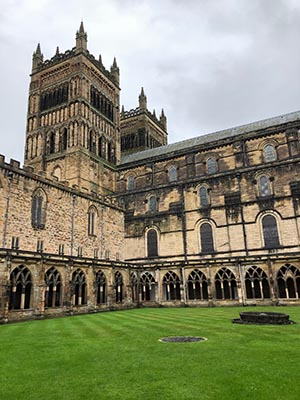 Durham
Durham
Durham Castle was unfortunately closed because of student move-in, which was a shame. The good thing was that there was a nice video to watch at the Visitors Center about the history of the cathedral and the life of St. Cuthbert, an important saint for Durham.
The cathedral itself was very impressive. We saw the tomb of the Venerable St. Bede (which included an inscription of one of his beautiful prayers: Christ is the morning star who when the night of this world is past brings to his saints the promise of the light of life and opens everlasting day) and the shrine of St. Cuthbert. One of the signs of St. Cuthbert’s holiness was the fact that his body did not rot in its coffin even after hundreds of years. It was therefore such a spiritually intimate experience to be at St. Cuthbert’s shrine, standing over his tomb where it was laid in the 1100s, his supposedly intact body right below my feet. We also saw the cloisters and the old monastery, which was miraculously preserved during the Reformation. We stood in the nave and threw our heads back to look up at the central bell tower—one of the tallest in Europe. And finally we enjoyed a splendid evensong service.
We spent the night in a hostel in Newcastle and had Newcastle brown ale, which admittedly mediocre.
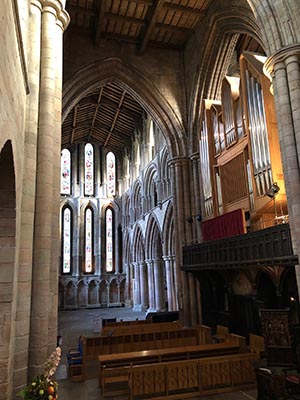 Hexham
Hexham
The next day we took a later start and went by rail to Hexham, where we visited Hexham Abbey. On our way there, my friend John asked me skeptically: why did you pick Hexham Abbey to visit again? He ended up rating the Abbey a 10/10, however, one of many reasons why I think the Abbey is underrated.
What makes the Abbey so great is its long 1300 year history and the way in which that history is still evident in the physical church itself. The Abbey began as an Anglo-Saxon church founded by Queen Etheldreda in c. 674, centuries before the site at Durham existed. The church was built from stones taken from Roman buildings, and the crypt of this church is still intact, despite the ravaging of the invading Danes. We got to go down into this crypt and we saw the decorative etchings on some of the Roman stones. I still shudder in awe when I think what it was like to be inside that ancient crypt.
In the nave of the church was a relief of the Roman Emperor Flavinus that was unearthed in the 1960s, as was the Roman column in York. I wonder how many other artifacts are still buried beneath the Abbey and, more generally, the town of Hexham itself!
But the history of the Abbey continues from the Saxons and the Danes. The Normans converted the church into a grand cathedral to show the Saxons who was boss. The Scots pillaged and burned the cathedral several times, and we could still see how the stones of the cathedral were pink, bearing the mark of these long ago conflagrations.
Perhaps one of the coolest parts of the Abbey were the pre-Reformation wood paintings in the Quire that miraculously survived the destruction of Henry VIII. They had been hidden away—who knows why—and now they are some of the last of their kind and a portal into another time when cathedrals all around England were decorated with colourful wood paintings, in contrast to today.
In the Quire we also found the stone cathedra from which St. Wilfrid himself administered the church as the bishop. This bishop’s throne must have been 1300 years old. And flanking the Quire were old Anglo-Saxon tombs.
The dangling spire at the end of the nave (which had been destroyed during the Reformation but rebuilt in the 1800/1900s) summed it all up: it was made up of the base of a Roman column, medieval metalwork, 19th century wood carvings, and a modern stone pedestal. The Abbey therefore really represent a slice through England’s history. It has so many stories to tell, and it does tell them—in its own way.
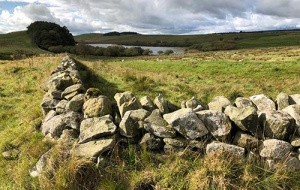 Hadrian’s Wall
Hadrian’s Wall
In the afternoon we hiked 2 miles along Hadrian’s Wall, from Housesteads Roman Fort to the Sill Visitors Center, going past well-preserved Roman milecastles and the Robin Hood sycamore. The skies were partly cloudy, and we got sprinkled on a few times. So fitting weather.
The Housesteads Roman Fort was incredible. You could still see the foundations of the fort—the huge principia where the leader of the fort would live, the barracks for the centurions themselves, the hospital, etc. I remember thinking, I wish I could send a photo of this to the people who used to live here. Could they have imagined that the buildings they used to walk in and out of every day would look like this two thousand years later? Would they be surprised to find out that Rome is no more? Would they be shocked that the base of their fort has survived all the intervening wars and kingdoms? …How much of our own world will still be here in another thousand years?
The highlight of the fort was definitely the well-preserved Roman latrines in the south-east corner of the fort. There, the stone pipes and sewers through which water would trickle by gravity were still intact. It was amazing. Parts of the rest of the fort were still preserved, such as the bases of some of the columns, the foundations of the barracks, the walls of the hospital, and the ruins of the gates. After all these years, those same stones which the Roman legionaries had placed on the ground were still there, unmoved. The world around them has changed, but these stones themselves persist.
We stayed overnight in Edinburgh after arriving there pretty late.
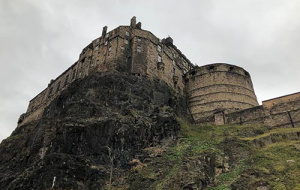 Edinburgh
Edinburgh
In Edinburgh, John and I walked the length of the Royal Mile and climbed both Calton Hill and King Arthur’s Seat—the latter in the dead of night. Might not have been the best decision, but we did see some faint colours in the sky that could have been the Northern Lights. We also saw the Scott monument and bits of both Old Town and New Town. We walked past St. Andrew’s and St. George’s West Church and the Canongate Kirk where the Queen worships when she’s in town. But the main church we visited was St. Giles’ Cathedral.
The weather was overcast and the city felt very gothic and autumnal. I loved it.
Edinburgh, despite being a major city in modern times, has retained much of its original character. People often think of small towns as being quaint, but Edinburgh somehow manages to be both quaint and a metropolitan center. There were many moments in Edinburgh where the look of the buildings and the streets, coupled with what I read in my travel guide, brought me back to the Middle Ages. The imagery was so evocative. I could imagine artisans weaving kilts and fabrics in the street windows of their homes. I could envision mothers in plain clothes churning butter or collecting water from the local pump. And despite all the cars there today, I could almost see knights riding up the final stretch of the Royal Mile to the Castle, colourful banners trailing in the wind from their steeds. Images like these snatched me from the present-day world and transported me to a different era. They are what made my travels so valuable.
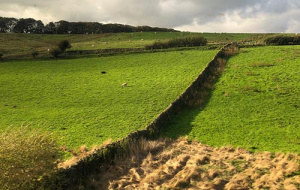 The In-Between
The In-Between
One of the best parts of my trips was actually the time spent in between towns on the train, gazing out the window at the land rolling past. I’ve fallen in love with the British landscape, despite not loving the rainy weather. My conscious recognition of this took full form on the train ride from Haltwhistle to Edinburgh.
My favourite part of the landscape of this country is how lush and green the grass is. The green is often made even prettier by the jewels of raindrops it frequently wears, which shimmer and sparkle in the sunlight. I really mean it when I say how impressed I am at the green-ness of the grass. Seeing such green grass in the States is very rare, because the only way to get the grass so green is to take excruciatingly good care of it. But here, the rain serves as a natural sprinkler. The grass here therefore grows so effortlessly green. Even the untended fields by the train tracks are a gorgeous emerald.
My favorite time of day to see the grass is in the late afternoon, when the slanted rays of the sun light the grass up into a fluorescent lime. The sheep and cattle grazing on the fields—dark silhouettes against the sun—cast long shadows on the grass. And then you look into the distance and see the same sort of green stretching as far as the eye can see. Just fields upon fields swimming in green, interrupted only by the meandering stream or the carefully planted shrubbery dividing the fields into rectangles. What a sight to behold!
My sincere gratitude and appreciation again for the Brewster Scholarship, which was enabled all this.
Find out more about the range of travel grants and scholarships available to assist Univ students on our Travel Grants page or read further travel reports.
Published: 4 December 2019
Explore Univ on social media
